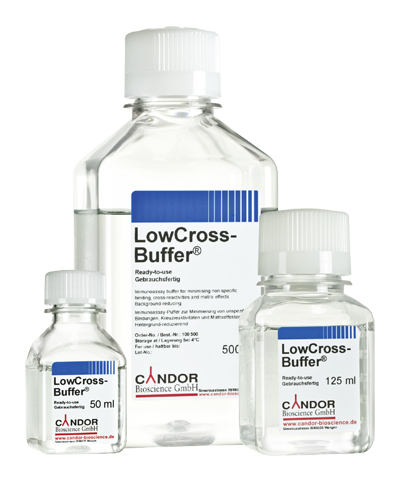LowCross-Buffer® - Sample Diluent
The Sample and Assay Diluent for minimizing nonspecific binding, cross-reactivities and matrix effects in immunoassays
Interference is frequently caused by human anti-mouse antibodies (HAMA), rheumatoid factors (RF) and elevated levels of bilirubin, triglycerides and others. The varied sources of such interferences make it impossible to be addressed adequately solely by HAMA blockers. HAMA blockers are limited in their effectiveness only against HAMA.
LowCross-Buffer® reduces interferences
In contrast LowCross-Buffer® as an assay buffer can efficiently deal with a multitude of interferences including those caused by HAMA. The unique formulation of LowCross-Buffer® helps to shield the specific signal from low or medium affinity cross-reactivities or interferences in immunoassays like an “affinity gate keeper”. Minimization of all these negative effects by LowCross-Buffer® upgrades the quality of the assay and improves the reliability of results. Diagnostic and pharmaceutical companies worldwide are successfully using LowCross-Buffer® as a cost-effective solution to minimize interference derived from multiple sources. It is used in ELISA, Western blotting, protein arrays, immunohistochemistry as well as in lateral flow assays. Furthermore it is used in fluorescence-based assays and SPR (surface plasmon resonance) assays.
![[Translate to Englisch:] LowCross-Buffer® als Probenverdünnungspuffer](/fileadmin/benutzerdaten/low-cross-buffer-com/bilder/results_LowCross.png)
LowCross-Buffer® is applicable for:
ELISA
ELISA is the abbreviation for Enzyme-Linked Immuno Sorbent Assay.
The principle is the binding of a labeled specific antibody to the target antigen (called analyte). The signal of the enzyme labeled antibody is the conversion of a substrate, which can be detected and quantified...more information
Western Blot/Line Blot
The Western blotting technique is used to detect proteins from crude mixtures. First, the proteins are separated by gel-electrophoresis into bands. Then all proteins are transferred to a membrane, where the target protein band is detected with primary antibodies specific to the target protein....more information
Immunohistochemistry
In immunohistochemistry or immunocytochemistry tissue or cell structures are stained by using antibodies. A very good local resolution can be achieved, if preparation of tissue slices is optimized and blocking of nonspecific binding is effective. Thus not only presence, but also localization of an analyte can be visualized. Detection is done commonly either by enzymatic substrate-conversion or by fluorescence-labeling...more information
Protein Array / Multiplex Assay
Protein arrays are miniaturized assays for detection of many proteins in parallel. They use proteins or antibodies immobilized on surfaces such as glass slides or beads. A single target protein is detected either by localization of a signal at a specific point in the array or by differences in the specific beads, which can be individually coded e.g. by color or fluorescence. The major advantage of this technique is that many analytes can be detected at the same time from one sample. But cross-talk between the multiplexed assays has to be avoided to enable sufficient reliability of results.....more information
Immuno-PCR
Immuno-PCR combines ELISA technique with the exponential signal enhancement of a PCR (polymerase chain reaction). The specific antibodies are labeled with a DNA marker. By using the amplification steps of the PCR, the sensitivity can be better compared to the “classic” ELISA. Due to the fact that signals from nonspecific binding are significantly enhanced by the PCR-reaction, false-positive results are very common. As a consequence effective blocking of the plate surface and avoiding of interference are extremely important for Immuno-PCR....more information

Are you interested in testing LowCross-Buffer®?
Please feel free to contact us:
Tel.: +49 7522 795270
support@candor-bioscience.de
Immuno-PCR









